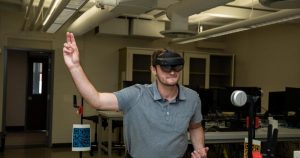Is Mixed Reality the future of coaching in sports?

The term “high-tech” has been associated with sports ever since sabermetrics was introduced to the world of baseball. The advancement of sabermetrics and technology has led to increased player tracking and the extensive use of analytics in coaching and roster management decisions. So far, all the data collected and analyzed has been post-play or post-game. However, thanks to a study conducted by the New Jersey Institute of Technology (NJIT), the utilization of real-time statistics could potentially revolutionize the way games are coached.
The study centers around a coach wearing the Mixed Reality Microsoft HoloLens headset. While watching the game, the coach receives “real-time statistics and facial interpretation data” to evaluate how to approach each pitch. This information guides decisions on whether the pitcher on the mound should continue pitching, walk the batter, or if it’s time to call the bullpen for a change. Coaches also have access to a team of remote analysts and trainers who receive the same information.
NJIT Associate Professor Tao Han emphasizes the power of this technology not only for in-game decisions but also for remote coaching. This advancement would enhance remote coaching done over platforms like Zoom or Webex, incorporating 3D holography to better train players. Professor Han interviewed coaches from various sports, including basketball, soccer, and football, and found that they appreciated understanding the players’ status through structured and visualized data.
One of Professor Han’s research assistants, Tyler Stafflinger, a former pitcher himself, sees this technology as a proactive approach rather than a reactive one for players and coaches. The ultimate aim is to predict “how batters are going to be approached, or how pitchers should approach the batters.” Stafflinger envisions the possibility of predicting the next pitch based on human habitual patterns.
In the world of professional sports, technology plays a significant role as teams strive to gain an edge over their competitors. However, some instances involve technology being misused for cheating. Professor Han, however, remains focused on the positive aspects and the potential applications of this technology. The scope of its use extends to other sports and industries, ranging from healthcare to training. Professor Han also envisions his telepresence solution as a potential “key technology that connects the physical world and the metaverse.”


